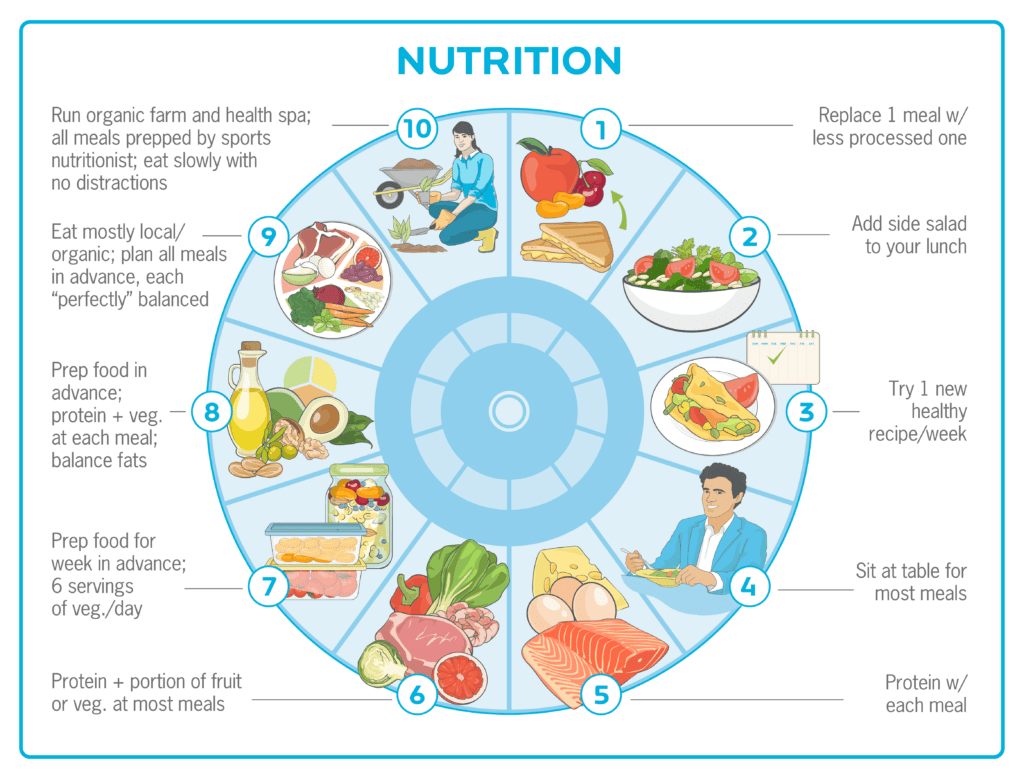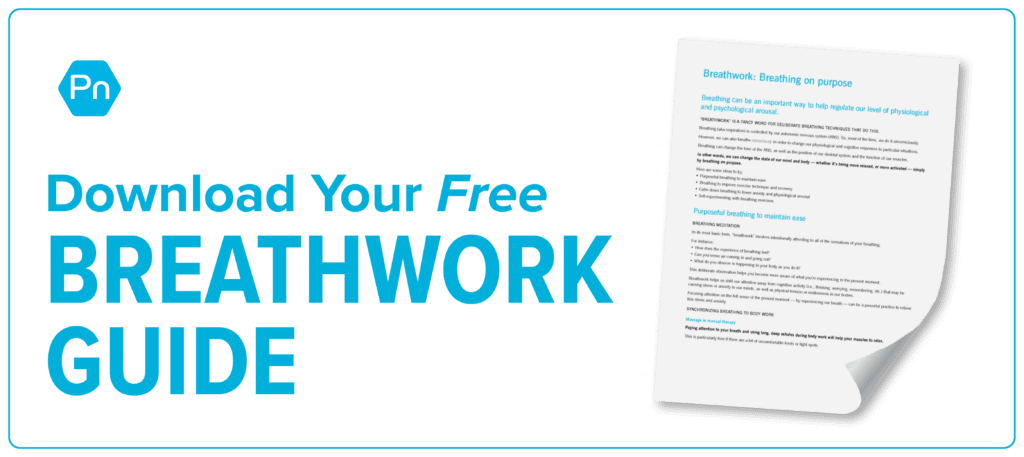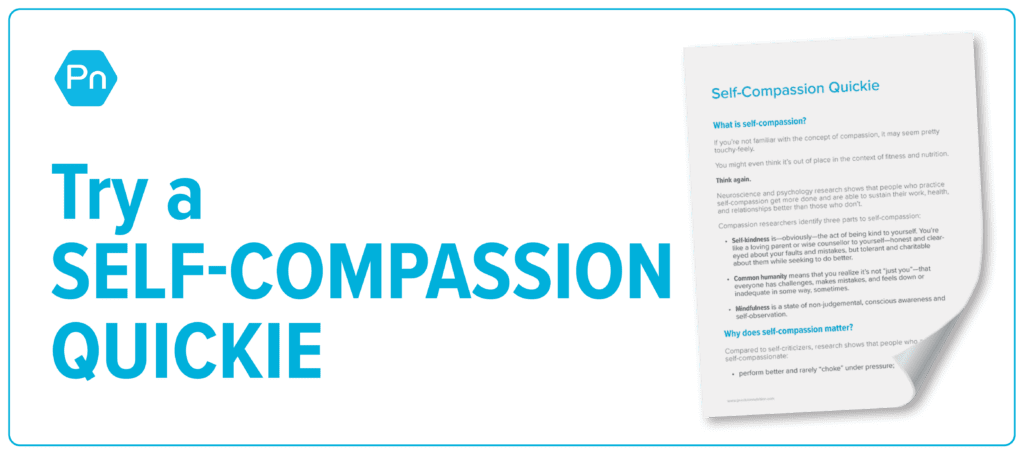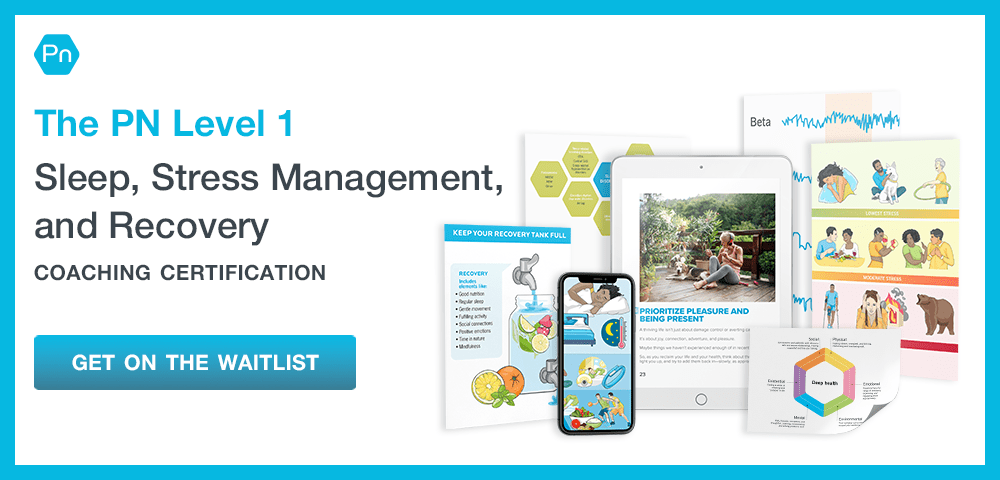The REAL reason clients quit, fail, or ghost you—and what to do about it
The text message read, “Sorry—I have to quit. Life is just so crazy right now.”
Tony tossed his phone down and sighed.
Tony Arreola, PN2, SSR, has been coaching for nearly two decades. In that time, he’s racked up plenty of success stories, body transformations, and loyal clients. Yet, despite his years of experience and education, certain clients were slipping through the cracks.
They stopped trying, canceled their coaching, or just ghosted him altogether.
After some reflection, Tony realized the commonality among these clients.
Stress.
Underneath every polite “Sorry, I can’t…” message was an iceberg of overwhelm and exhaustion.
But once Tony addressed the root cause, something awesome happened:
His clients started showing up differently. They displayed more grit, grace, and gains—even when life went sideways.
We spoke to several other PN Certified Sleep, Stress Management, and Recovery Coaches who reported similar stories, and they’ve shared their insights with us.
Here are four strategies to determine if stress is holding clients back, and if so, how to help them persevere, and feel better.
++++
Strategy #1: Gauge clients’ stress levels early on.
“The people who quit never said they were too stressed out,” says Tony.
“They would say things like, ‘Oh, the kids are going back to school,’ or ‘We’re getting ready for this big thing coming up,’ or ‘My situation at work has changed.’”
But after becoming a PN Certified Sleep, Stress Management, and Recovery Coach, Tony realized: “They’ve all been telling me the same thing. They’re stressed and overwhelmed and they don’t know how to cope.”
Jaylee Thomas, PN1, SSR, Pilates instructor, meditation teacher, and nutrition coach in Vancouver, British Columbia, mirrors the observation:
“Clients don’t say they can’t continue their coaching because they’re too stressed out. They just… stop. Stop checking in, stop doing the assignments I’ve given them, stop responding to messages.”
What does this tell us?
When it comes to addressing stress, don’t leave it up to your clients to ask for help. Take the lead.
Put it into action
 Include questions about stress in your intake.
Include questions about stress in your intake.
Tony now asks all clients about their stress levels.
“When someone tells me they want to get in shape, I ask them two questions:
- Question #1: What’s your current stress load?
- Question #2: How do you manage your stress?”
This helps him understand what clients are dealing with, how much capacity they have for change, and how he can best help them.
(Want to help clients assess their readiness and ability to take on change? Get them to fill out the Change Capacity Assessment.)
 Help clients plan for inevitable stress.
Help clients plan for inevitable stress.
A client might intend to hit the gym the moment they finish work, but what if their commute runs long? Or their kid has to come home early from school?
That’s where planning comes in.
“I help my clients plan ahead, because the ideal situation rarely happens, “ says Rob Klein, PN2, SSR, a health coach based in Fair Lawn, New Jersey.
“I’ll say, ‘Okay, if things don’t go according to plan A, what’s plan B, plan C?’ Now we know if things don’t go perfectly, we’ve got an alternative.”
 Check in regularly about your client’s stress levels.
Check in regularly about your client’s stress levels.
When you know where your clients’ stress levels are at, you can modify programming, and/or implement more recovery.
To do this, Tony monitors his client’s stress “temperature” as part of a weekly check-in.
“Along with questions about their sleep, movement, and nutrition, I’ll ask, ‘What’s your stress load for the week? Give me a number between 1 and 10.’”

Note: “Some clients get stressed out just by the word ‘stress,’” warns Jaylee. For them, you might phrase the question differently. Something like, “What’s going on in your life right now?” can invite your client to talk about challenges they might be facing.
If they’re hesitant, be patient.
“It can take time to build trust,” notes Shauna Hammer, PN1, SSR, a CrossFit and nutrition coach in Unity, Saskatchewan. “But if I offer continued positive support, show them that I’m here no matter what their life looks like, in time they open up a bit more.”
Strategy #2: Treat stress management as a habit like any other
Stress management is a skill.
And like all skills, it’s something you can get better at.
“When I ask new clients how they manage stress, many of them tell me, ‘No one can manage stress,’” says Tony. “But that’s not true.”
There are many techniques and tools you can use to help clients improve their stress management—starting with helping them understand it IS something they can improve.
Put it into action
 Aim for one percent better.
Aim for one percent better.
“Eventually stress management becomes second nature,” says Rob. “But we have to work at it, especially in the beginning.”
Tony recalls a client who’s been with him for three years:
“In the beginning, he was stressed to the max. Now he says to me, ‘My stress is still at a level 9 or 10, but I deal with it differently. I come home from work at a reasonable time, have a nice dinner with my wife, get a good night’s sleep, and move on to the next day.’”
“We did a lot of things to get to this point,” says Tony. “It doesn’t happen from just one method, but with many small practices over time.”
 Look for small ways to release the pressure.
Look for small ways to release the pressure.
“Stress is going to happen,” says Jaylee. “But we do have the power to release pressure from the valve throughout the day.”
The exact “pressure-releasing” practices can vary from person-to-person—but here are a few ideas:
- Take a walk without your phone. (“Even walking one single block will start to relax your nervous system,” says Jaylee.)
- Do a brain dump. (“Write down your thoughts on a piece of paper to get them out of your head, especially before bed,” says Rob.)
- Focus on what you can control. (“Try a ‘spheres of control,’ exercise,” suggests Tony.)
- Do something fun. (“People think they’re being ‘good’ by being super focused on their eating or exercise, but they don’t realize that hyper-focusing is a form of stress. Life is short, so plan for some fun in your week,” says Rob.)
(Still feel like you’re “failing” at self-care? Read: Three self-care strategies that work—no bubble bath required)
 Breathe.
Breathe.
Breathing is a great place to start for clients of all levels. It’s easy, effective—and it doesn’t cost a thing.
If a client walks into the gym super stressed, Tony asks them to take a few deep breaths before getting started.
Inevitably, clients feel some relief. Tony tells them: “We’re not going to get rid of stress completely. But we can make it just a little better, bring a bit more calmness into your day.”
(Want our complete breathwork guide? Download it now at no cost.)
Strategy #3: Help people be less of a jerk to themselves
We asked all the coaches interviewed for this article what their clients’ biggest stress point is.
Was it work? Relationships? Lack of sleep? The pandemic?
Nope.
Every one of them said “beating themselves up” was #1.
For many people, the biggest source of stress is… themselves.
“The number one factor in client success or failure is the story they tell themselves. If my clients beat themselves up, it’s going to be really difficult for them to change,” says Tony.
Shauna agrees. “Feeling bad about yourself just adds to your stress. If people have positive regard for themselves, they’re more likely to have the capacity for change, and to come back after a failure.”
Put it into action
 Relentlessly call out small wins and bright spots.
Relentlessly call out small wins and bright spots.
“When clients are struggling, they tend to be hard on themselves. I’m always on the lookout for small wins they might’ve missed,” says Shauna.
“For example, suppose a client emails me to say they’ve been too busy with their kids so they haven’t been able to check in, or get their food prep done, and they feel awful about it.
“I might say something like, ‘you’re so dedicated to your parenting. I really admire that about you, and the effort you’re making with your nutrition means you’re being a positive role model to your kids.’”
Rob adds: “If my clients feel like they’re failing, I ask them to pause and do a little reflection to see how far they’ve come.
“I might ask: What would your previous self be doing in this situation right now? What things have you improved since then? When they look back, they can usually identify signs of progress they might have missed.”
Of course, the trick is to do this without veering into toxic positivity. It pairs well with listening and empathizing, noted in Strategy #4.
(Tip: Use the Bright Spots Tracker to help clients record things that go well, so they have evidence of their success.)![]()
 Track other forms of progress (besides the scale).
Track other forms of progress (besides the scale).
“At the beginning of our work together, I have clients develop a list of things they want to pay attention to, besides weight loss,” says Jaylee. “It might be energy levels, mood, snappiness with people, and so on. Whatever is important to them.”
If a client feels frustrated with a lack of progress, Jaylee has them review the list and notice changes.
“You can help your client take pride in things they might have otherwise overlooked. When we feel successful, we’re more likely to keep going.”
 Notice and name negative self-talk.
Notice and name negative self-talk.
Changing your thoughts isn’t easy—especially if self-criticism feels like a grimy security blanket you just can’t quit.
Sometimes, professional help is required. But coaches can still be advocates and role models for healthier self-talk.
Jaylee recommends the notice-and-name approach:
“I tell my clients, you have to name it to tame it. If an overly critical or judgy thought pops up in your mind, just acknowledge it. You don’t have to change it, just pause. When you notice it, you can let it go and move on.”
Jaylee sees the results: “In time, my clients are less hard on themselves, or they’re hard on themselves for shorter amounts of time. And the less they beat themselves up, the more energy they have for other things.”
(One of the best ways to disrupt negative self-talk? Self-compassion. Try a quickie here.)
Strategy #4: Meet your clients where they’re at
In dark times, coaches can be a source of light and comfort—simply by showing up with empathy and understanding.
“I think what people need most is just to have someone in their corner,” says Tony. “I might be the only person who is really listening and empathizing with them in their lives.”
“I try to be very compassionate because it IS hard,” adds Jaylee. “People don’t have any extra bandwidth these days. They’re already so stretched. I don’t want to add to the stress.”
Put it into action
 Adjust habits to make them more doable in stressful times.
Adjust habits to make them more doable in stressful times.
Many clients suffer from all-or-nothing thinking: If they can’t do their program perfectly, rather than scale things back—they quit.
Instead, coaches can help them learn to adjust their “life dials.”
(In the example below, the nutrition “dial” can be turned up or down according to a person’s capacity.)

Rob, who’s had multiple sclerosis for 23 years, is very familiar with scaling efforts up and down, depending on his symptoms. He shares that strategy with his clients:
“Imagine your effort on a scale from 1-10. Maybe you wanted to be working out at a level 8, 9, or 10 today but something happened and you’re only at a level 2. Fine—you’re doing something rather than nothing, and that’s always better.”
Tony adds that even when clients can only handle very simple tasks, they can still get results:
“I have one client who’s been so stressed out. I gave him just one habit to start with—drink more water. That’s it. It’s been four months, and he’s down 12 pounds.”
 Listen and empathize, without trying to solve.
Listen and empathize, without trying to solve.
Tony learned that sometimes, the best thing he can do is just be present.
“Before I took the PN Certification, I had a huge blind spot with this stuff. If clients were stressed, I basically would have said, ‘get over it.’ I see now that wasn’t very helpful.”
“These days, If a client is stressed out and needs to vent, I just sit in the fire with them,” he says. “I acknowledge what they’re going through. After a little while, their energy shifts and they’re ready to go forward.”
Sitting in the fire with a client is different than trying to put out the fire for them:
“I don’t try to solve their problems,” clarifies Tony. “I just listen and empathize. Nothing is going to get solved in our conversation, but they feel better because they’ve been heard.”
Sometimes, empathizing can involve letting your clients see your human side.
“I’m an open book with my clients,” says Rob. “I tell them about my MS. I explain that I can’t control my body and how it’s going to react and what it’s going to feel like on a given day.”
By sharing a bit of his own story, Rob’s clients know they’re not alone.
 Give people space if they need it.
Give people space if they need it.
Sometimes, people just need a break—and that’s okay too.
“I’ve had situations where something significant has happened to a client, a death in the family or a family emergency,” says Jaylee. “In those cases I try to give the person some space. I want to acknowledge their priorities have shifted. I let them know I’m here, but I don’t overdo it.”
Most importantly, Shauna remembers to keep clients in charge:
“I always think that the client needs to direct where they want to go and the amount of effort that they’re willing and able to put in. It’s my job to meet them where they’re at.”
If you’re a health and fitness pro…
Learning how to help clients manage stress and optimize sleep can massively change your clients’ results.
They’ll get “unstuck” and finally move forward—whether they want to eat better, move more, lose weight, or reclaim their health.
Plus, it’ll give you the confidence and credibility as a specialized coach who can solve the biggest problems blocking any clients’ progress.
The brand-new PN Level 1 Sleep, Stress Management, and Recovery Coaching Certification will show you how.
The post The REAL reason clients quit, fail, or ghost you—and what to do about it appeared first on Precision Nutrition.






Nenhum comentário